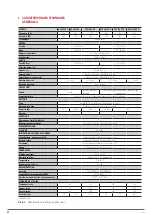
20
SALICRU
5. INSTALLATION
•
Read and follow the Safety Information set out in
chapter 2 of this document. Failure to adhere to any of
the indications set out in chapter 2 may cause a serious or
very serious accident for those who are in direct contact
with the unit or who are in the vicinity, as well as faults in
the unit and/or in the loads connected to it.
•
Check that the information on the name plate is the right
information for the installation.
•
Once you have unpacked the unit, inspect it and ensure that it
is in perfect condition before proceeding. If this is not the case,
please contact your distributor.
•
Always bear in mind that the UPS is an electrical gen-
erator, which is why the user must take the necessary pre-
cautions to prevent direct or indirect contact.
5.1. LOCATION AND STORAGE CONDITIONS
•
Install the UPS in a protected area that does not have ex-
cessive humidity but has suitable ventilation.
•
Place the UPS at a distance of at least 20 cm from other
units to prevent interference.
•
Do not operate the unit where the temperature and hu-
midity exceed the permitted limits (see the technical speci-
fications).
20 cm
20 cm
SPS PC 650/850 VA
10 mm
37 mm
SPS PC 1000 VA
11 mm
40 mm
100 mm
16,80 mm
85 mm
11 mm
SPS PC 650/850 VA
SPS PC 1000 VA
50
.0
0 m
m
8.50 mm
42.50 mm
5.
50 m
m
RAL 9010
RAL 9010
Fig. 4.
Location of the UPS
5.2. CONNECTING THE UNIT TO THE MAINS FOR THE
FIRST TIME OR AFTER IT HAS BEEN OUT OF USE
FOR TWO MONTHS
•
Insert the mains plug into an AC socket.
•
For the best results, charge the battery for at least 8 hours
before using the unit for the first time or when it has been
out of use for more than two months.
Otherwise, the SPS.PC may not react in a satisfactory way
if there is a power supply failure during the initial operating
hours. Its response capacity during unexpected AC power
supply failures is dependent on the energy accumulated in
the battery.
•
The battery charges by simply connecting the unit to the
mains.
5.3. CONNECTING THE LOADS.
•
With the unit switched off and disconnected from the
mains, connect the loads to the sockets
on the rear of
the unit.
•
Never connect a laser printer or scanner to the UPS.
This may damage the unit and/or consume the energy
stored in the batteries, which is reserved for other more
sensitive and more important types of loads.
5.4. STARTING UP/STOPPING THE UNIT
5.4.1. Starting up the SPS.PC
•
With the SPS.PC stopped, press the
button for 2 sec-
onds to start the unit. The LED will be lit and an acoustic
warning will be emitted.
•
Connect and start up the loads.
•
If an overload is detected, an acoustic alarm will be acti-
vated. Stop the UPS, disconnect one of the loads, wait 10
seconds and start the unit up again.
•
The acoustic alarm can be muted by pressing the
start button on the front twice - 2 short beeps will be
heard. To reactivate it, press the button twice again - 1
short beep will be heard.
5.4.2. Stopping the SPS.PC
•
Stopping the loads.
•
Switch the unit off, press the
button for 2 seconds.
Summary of Contents for SPS 1000 PC
Page 2: ...2 SALICRU...
Page 33: ...33...















































